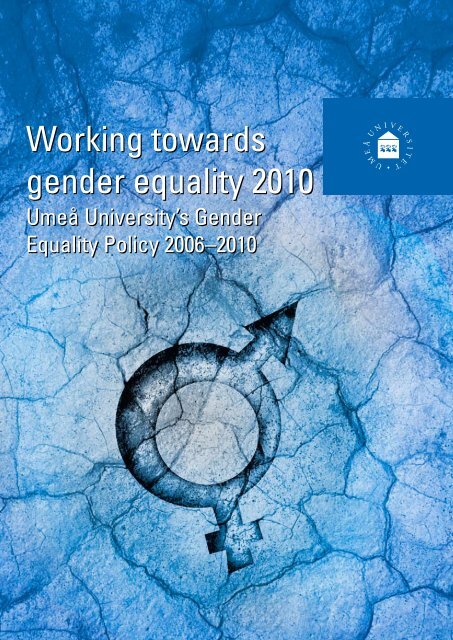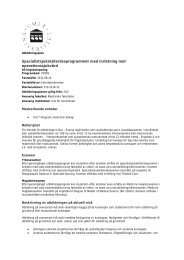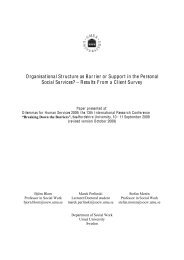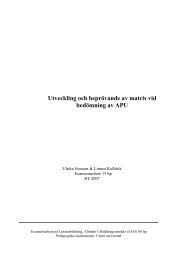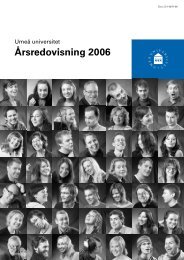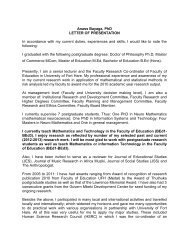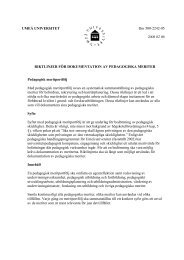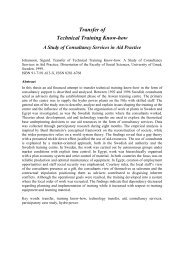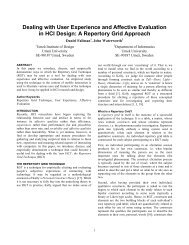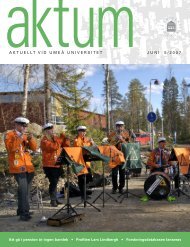Gender Equality Policy
Gender Equality Policy
Gender Equality Policy
You also want an ePaper? Increase the reach of your titles
YUMPU automatically turns print PDFs into web optimized ePapers that Google loves.
Working towardsgender equality 2010Umeå University’s <strong>Gender</strong><strong>Equality</strong> <strong>Policy</strong> 2006–2010
BackgroundThe current picture of gender equality is based onquantitative measurements for the university’s researchand teaching personnel. It shows that therehas been considerable improvement over the last10 years. There has, for example, been an evengender distribution among doctoral students andlecturers for several years. The proportion of femalesenior lecturers has risen steadily and therehas been a positive development with regard to thenumber of women who are assistant professors. Onthe other hand, the number of female professorshas risen quite slowly, despite Umeå University‘stop ranking in terms of the percentage of femaleprofessors recruited.The proportion of women, in percent in different academic categories 1995–2010605040302010Andel kvinnor i procent01995 1996 1997 1998 1999 2000 2001 2002 2003 2004 2005 2006 2007 2008 2009 2010ÅrLecturersDoctoral studentsSenior LecturersAssistant professorsProfessorsLecturers 05–10Doctoral students 05–10Senior Lecturers 05–10Assistant professors 05–10Professors 05–10Figure 1 – The proportion of women, in percent, in different academic categories. 1995–2010
The imbalance within other groups of personnelis, generally speaking, greater and achieving the desiredratio of women to men in these areas is progressingslowly. The proportion of women administratorsand librarians is sizeable, but the oppositeis true in the case of computer personnel, wherethe number of women has decreased since 1995.However, with regard to technical staff, a genderbalance appears to be being maintained.The proportion of women, in percent, technical and administrative personnel01995 1996 1997 1998 1999 2000 2001 2002 2003 2004 2005 2006 2007 2008 2009 2010År100908070605040302010Andel kvinnor i procentAdministration personnelLibrariansComputer personnelTechnical personnelAdministration personnel 05–10Librarians 05–10Computer personnel 05–10Technical personnel 05–10Figure 2. The proportion of women, in percent, technical and administrative personnel 1995–2010An estimate of how the ratio of women to menwithin these different personnel groups wouldchange if the vision of the gender equal Umeå Universitywere to be achieved by the year 2010, hasbeen added to the end of both diagrams. The currentsituation has been used in order to show howworking towards gender equality has contributedto a positive change within many areas. Nevertheless,this does not give a representative picture ofthe situation with regard to gender equality withinall aspects of the university’s activities. If theaggregated numbers in the diagrams are brokendown on departmental and faculty levels or intoemployee categories, then further pictures of genderinequality appear. For example, the proportionof female senior lecturers within the Facultyof Science and Technology is considerably largerthan in the Faculty of Social Sciences. On the otherhand, women make up the clear majority amonglaboratory assistants and cleaners, while the majorityof caretakers and engineers are men. Thereare many more such examples which underscorethe fact that achieving gender equality within allpersonnel categories is a very complex task whichdemands detailed knowledge. Fulfilling the goalof gender equality, regardless of whether or not itis qualitatively or quantitatively measured, mustalways be placed in a broader context. For example,in order to reach the goal that at least 40% ofall professors are female, then the proportion offemale senior lecturers must also increase. In thesame way, if the proportion of male secretaries isto increase, then the goal must be set in relationto the organizational changes necessary withinthe university’s administration to affect the totalnumber of secretaries. For these reasons, settinggender equality within the right context willlead the way to fulfilling the vision of a universityworking towards complete gender equality bythe year 2010.
OrganisationThe University’s Council bears the main responsibilityfor the continued work with gender equality.The university’s Vice-Chancellor is responsible foroverseeing this work. Pro-vice-chancellors, deans,heads of department and other administrators areresponsible for questions of gender equality withintheir respective areas. The policy for gender equalityshould be seen as a support and a tool for implementinggender equality. Departments, centresand academic and administrative units made upof more than 10 employees must establish a planfor achieving gender equality, as well as evaluateand revise it annually. The estimated costs for themeasures suggested for reaching these long-termgoals should be included as a natural extension ofeach department/unit’s budget. The Vice-Chancellorhas appointed a gender equality committee responsiblefor working strategically with questionsof gender equality with regard to the university’sstudents and staff. The committee is also responsiblefor following up, analysing, and suggestingmeasures within the area of gender equality.The faculty boards have a strong standing in relationto gender equality. Every board has a representativein gender equality committee. The remainingmembers of the committee representother activities, such as the Centre for Women’sStudies, union organizations, and the studentunions. The secretary and administrative resourcewithin the committee is the Coordinatorfor <strong>Gender</strong> <strong>Equality</strong>, who is located in the Officefor Human Resources and Organizational Development.The committee for gender equality hasan executive committee comprised of a chair, astudent representative, and the Coordinator for<strong>Gender</strong> <strong>Equality</strong>. The Coordinator is responsiblefor managing the overarching, strategic workat the university. Within every faculty and at centrallevel, there is an executive officer responsiblefor coordinating the various activities concerninggender equality. Departments and academic andadministrative units must appoint a representativeor a group, consisting of both women and men,responsible for gender equality. The Committeefor <strong>Gender</strong> <strong>Equality</strong> is presented on the followingwebpage: .The Vice-Chancellor has also appointed anEqual Opportunities Committee. This committeeworks with the same sorts of questions as theCommittee for <strong>Gender</strong> <strong>Equality</strong>, but from the perspectiveof equal opportunities for all regardless ofethnicity, sex, disability, sexual proclivity, and soforth. Issues concerning discrimination and harassmentare also human rights issues. The committeedeals with questions concerning discriminationon the grounds of gender, ethnicity, disability, andsexual proclivity and with sexual harassment. Thecommittee’s policy concerning discrimination andharassment can be found here: .
Aims for Umeå University with regardto its work with gender equality 2006–2010The quantitative aim for the period 2005-2008has been approved by Umeå University Councilfor three academic categories. In the case of professors,the Swedish National Agency for HigherEducation has also set a target, which is somewhatlower than that set by Umeå university. These goalscan be seen below:UmeåUniversityProfessors at least 40% 34%womenResearch at least 40% N/Aassistants womenLecturers at least 40% N/AwomenSwedish NationalAgency for HigherEducationThe University Council has not set any quantitativeaims for other categories such as technical and administrativestaff. The Swedish gender equality lawrequires that the underrepresented sex must reachat least 40%, and this applies to all categories ofemployees. The same rule applies to students registeredin free-standing courses and educational programmes.This has been approved by Parliamentand the Government and is outlined in the University’shandbook. Through student participation, it ishoped that a raised level of awareness will be generatedin the form of concrete measures concerning,for example, information and recruitment.In addition to the statutory requirements for thefollow-up and evaluation of gender equality policiesand equal pay, it is also important to follow upthe strategies developed to create and maintain genderequality at Umeå University. In order to be ableto follow up the results of activities aimed at promotinggender equality, reliable statistics are necessary.Databases, reporting systems, and statisticalprograms need to be continuously developed andimproved and made available as tools to the faculties,departments and academic and administrativeunits. The main goal is to provide the organizationswith a foundation which facilitates activities such asthe follow-up, evaluation and development of genderequality. <strong>Gender</strong> equality and the gender perspectiveshould be integrated and be made visiblein all activities at Umeå University. One way to accomplishthis is through the integration of a genderequal perspective. Through the use of centrallycollected statistics, the development of activitiesinvolving gender equality can be analysed and followedup so that work with integration can proceed.The ratio of females to males when it comes to, forexample, heads of departments, absence due to illness,and rehabilitation should be given special attentionin these statistics.Departments and programme committees willbe able to apply for gender equality certificationand the tools to enable them to do so will be developedover the next five years. The aim is to havea number of departments begin working with genderequality certification during 2006 and that, by2010, at least five departments will have applied fortheir courses or programmes to be certified.The knowledge that gender research produces willbe utilized in working towards greater gender equality.The Committee for <strong>Gender</strong> <strong>Equality</strong> will followup this research annually, for example through theuniversity’s graduate school of gender studies, andmake use of these results in workshops and seminars,thereby driving the process forward. Departmentswill be encouraged to plan and work concretely witha gender equality perspective in both undergraduateand postgraduate studies. Umeå University alsohas a responsibility to continually and actively followup and evaluate how the gender perspective isimplemented at an undergraduate level.
<strong>Gender</strong> equality will be integrated into the differentareas of professional development, such as theuniversity’s managerial training, postgraduate studentadvisor training, and postgraduate studies.Departmental and unit heads are responsible forensuring that all policies supporting competencedevelopment are implemented and that womenand men within all personnel categories are givenequal opportunities for their professional development.Departmental and unit heads mustalso guarantee that all resources are evenly distributed.In all boards, committees and workingcommittees, both women’s and men’s knowledgeand experience should be utilized, and at no timeshould one gender have less than 40% representation.With regard to faculty nominations for universitylevel positions, committees and so on, specialconsideration should be taken to ensure thatboth women and men are nominated.<strong>Gender</strong> equalityfor staff and studentsUniversity management andadministrationWork on gender equality is an integrated part ofall existing activity at Umeå University. The divisionof responsibilities between the different levelsis shown in the previous organizational diagram,as are the duties which each faculty, department/unit, university board and administrative unit isobliged to carry out. It is important that all staffand students are aware of the active measures forachieving gender equality that have been introducedfor each organizational level.The university management has the main responsibilityfor work within the area of genderequality and must, therefore, follow up progressannually through reports and feedback from theCommittee for <strong>Gender</strong> <strong>Equality</strong>. Managementand managerial questions in relation to the university’spolicy programs for gender equality mustbe heeded, in every situation. The gender equalityperspective must always be considered in the caseof education and development. Management andmanagerial development will be prioritized and developed.The university management will:• ensure that an even gender distribution is maintainedamong the university’s governors andmanagers• ensure that management and managerial questionsrelating to gender equality will be exploredduring planning and professional developmentdays and similar activities• integrate questions of gender equality and relevantknowledge in education and developmentalinitiatives, for example, within the universitydirector and managerial development program(UCL – universitetets chefs- och ledarutvecklingsprogram)• implement managerial development for currentor prospective heads of departments representingthe underrepresented gender• actively work for the early adoption of a genderequality perspective, for example, in the form ofa managerial development program.The university management has an importantfunction in relation to the development of workwith gender equality. The management heads haveat their disposal academic/administrative units andresources which they can use to map out, analyzeand actively work with gender equality measures.This will mainly be accomplished though the carefulanalysis of statistics concerning gender distributionat all levels of the university. The managementof the university will develop and improve
ConclusionWorking actively with gender equality at UmeåUniversity in the last decade has meant that therehas been a quantitative improvement in many areas,and that the qualitative work has been strengthened.As stated earlier in this policy, there appearsto be a fairly even gender distribution amongstthose employed as teachers and researchers. Theaggregated numbers hide the differences betweenthe faculties and between other parts of the university.This means that recruitment aims should beset in relation to each individual faculty, not leastwith regard to how future retirement will changethe shape of the department. Technical and administrativepersonnel questions should addresshow the type of work and organization can be redistributedfrom a gender equality perspective. Experiencegained over the last few years from workingwith these questions has shown the need for‘maintenance’, which involves following up howthe legislation and policies are experienced andhow they affect different groups of staff and students.The goal of the developmental program,”Vision Umeå University 2010” of a gender equaluniversity in the year 2010 contains a challenge. Inorder to reach this goal, it is necessary to becomediligent and active with regard to gender equalityat all levels of Umeå University.Additional information aboutgender equality and discriminationUmeå University’s Work with <strong>Gender</strong> <strong>Equality</strong>(in Swedish)<strong>Gender</strong> <strong>Equality</strong> Law(in Swedish)Higher Education Act, in particular 5 §.(in Swedish)Higher Education Ordinance, in particular chapter1, 8 §,as well as the attachment: The DegreeOrdinance for certain curriculum.(in Swedish)Measurements against discrimination andharassment(in Swedish)The Equal Opportunities Act for students (in Swedish)Process policy for students (in Swedish)The Equal Opportunities Ombudsman (in Swedish and English)Ombudsman for Ethnic Discrimination (in Swedish, partly in English)The Ombudsman against Discrimination ongrounds of Sexual Orientation (in Swedish and English)The Swedish Disability Ombudsman (in Swedish and English)12
Appendix 1Certificate of <strong>Gender</strong> <strong>Equality</strong>AimThe aim of a voluntary system of gender equalitycertification is to push Umeå University to becomea leader within the area of gender equality.The certificate for gender equality will raise awarenessof the importance of work in this area, as wellas improve its quality.GoalInitially, certification will be given for work withprogrammes and courses.The roll of the University CouncilThe University Council commissioned the Committeefor <strong>Gender</strong> <strong>Equality</strong> to be responsible forthe certificate for gender equality. Part of the committee’stask is to assess and support those participatingin the process of certification.The roll of the Committee for <strong>Gender</strong><strong>Equality</strong>The Committee for <strong>Gender</strong> <strong>Equality</strong> is responsiblefor the development and establishment of thecriteria for the certification of gender equality. Itis responsible for providing information, education,advice, and support in this process. The committeehas the additional function of being the decidingand controlling body, as well as acting asa support system for the departmental and facultygender equality representatives. The committeealso has the task of establishing collaborationswith external partners within this field.Faculty advisors for gender equalityFaculty advisors have an important and central positionin the process of certification. Work at thefaculty level operates closely with the student organizations.Departments and academic/administrativeunits can turn to these advisors for guidanceand advice. The advisors or groups bring togetherexperience in this area, which is an important contributionto the exchange of ideas in the process ofdeveloping the system of certification.Criteria for applying for a voluntarycertificate of gender equalityThere are three starting points upon which theframework governing the process of certificationis built. These are:• quantitative and qualitative work from a genderequality perspective• external and internal work from a gender equalityperspective• the students and staff.These three points are weighed together and constitutethe basis for all applications. In addition tothese basic criteria, there should also be a number ofcriteria which the departments themselves have approved,in conjunction with the faculty advisors.Quantitative and qualitative aspectsWork on quantitative gender equality deals withexamining the gender distribution throughout theprogrammes and courses offered at the undergraduatelevel, as well as work towards achieving theproposed 40–60 percent distribution between thesexes. The same objectives apply to all categoriesof employees. The qualitative aspects concern ensuringthat the knowledge, experiences and valuesof both men and women are utilized to enrichand influence the departments’ development.Qualitative gender equality is also, to a large extent,about participating in self-evaluation and reflectionaround one’s own activities. For example,a department could begin a discussion forum andcontinuously evaluate its aims as one way of workingqualitatively with questions of gender.13
Internal/ExternalDepartments will work actively with issues concerninggender equality both internally and externally,as well as illustrate what it means for theirprogrammes and courses to be marked as genderequal. The aim of certification is to stimulate thedepartment’s own development, as well as to influencethe world around. This can, for example,be accomplished through thematically planneddays, the formation of gender studies groups,and through the integration of a gender perspectiveinto courses and programmes through literaturelists and informational material. It is essentialthat activities are directed towards both internaland external endeavors. Departmental cooperationis one example of the value of working towardsgender equality.Students and employeesWhen applying for gender equality certification, itis very important that both students and staff understandwhat this means. The work with voluntarycertification requires that those applying forcertification inform all those associated with or affectedby the process. Cooperation with studentsmust, therefore, be prioritized. Students shouldbe represented throughout the entire certificationprocess, in the setting of aims, in planning,in documentation as well as during the follow-upand evaluation. The departmental gender equalityrepresentatives provide an important resource.By encouraging students to become engaged in,for example, gender equality groups, the genderequality representatives can show the students howthey are able to have an effect within the department.With regard to student representation, thethree student unions can play an important roll inencouraging and supporting students who workwith questions of gender equality.Information and DocumentationDepartments should continuously document theirwork in relation to certification. This documentationshould include a plan of concrete measuresfor how courses and programs will develop. A timeplan for the completion of activities should alsobe included. Everyone involved in the activitiesshould be aware of how the aims are formulated,as well as be informed about the ongoing departmentalwork towards certification. The documentationshould lay the groundwork for the evaluationof the department’s efforts. It is importantto emphasise that the plan for certification will bepart of the department’s gender equality policy.Through this documentation, it will also be possibleto map the thought processes which could becomea tool for self-evaluation – which is a centralpart of the certification of gender equality process.Applicants must work actively in accordance withthe certification criteria for one year before certificationcan be granted.14
Appendix 2Tasks of the gender equality representatives or representativegroup at the departmental or unit levelExperience from the university’s work with genderequality shows that the foundation for this work isformed by the departmental and unit activities. Departmentand unit heads are responsible for the establishmentof a gender equality policy and forensuring that work is carried out within the department/unit.The task of the gender equality representativesor representative group is to work closelywith the department/unit heads. The goal is thatthe work with gender equality will become a regular,integrated part of departmental/unit planning.Currently, the policy for gender equality forms partof the department’s or unit’s annual report. Specialinstructions and the areas that need to be addressedare attached to the material used in planning futureactivities/measures. According to the Swedish genderequality law, workplaces with more than 10 employeesmust have a policy for gender equality. Inthis respect, this applies to practically every department,centre and unit at the university. The genderequality law also states what must be included in apolicy for gender equality.The plan must comprise three different parts: a follow-upto the previous year’s policies; a descriptionof current work; and an action plan. Good examplesof policies are published on the website for <strong>Gender</strong><strong>Equality</strong> Activities at Umeå University, . Departmentsand units are required to submit their policies totheir respective faculties and to the Coordinator for<strong>Gender</strong> <strong>Equality</strong>, as well as those reports preparedby the gender equality representatives or representativegroups.Each department or unit must appoint one femaleand one male gender equality representative or arepresentative group comprised of equal numbersof women and men. In the case of the departments,one of the representatives must be a member of theteaching staff. Those departments who so wish, mayinclude students in the representative group. Representativesor a representative of the group must havethe right to be present at departmental board meetingswhen points concerning gender equality are discussed.The department or unit heads should reachagreement with representatives over the scope andcontent of their task. The representatives, or group,should not have a shorter mandate period than twoyears. In order to have good continuality while workingwith questions of gender equality, the representativesor the members of the gender equality groupshould not all be replaced at the same time.The task of being the gender equality representativehas developed over the past few years and variesbetween the different departments and units. Achievingprogress with the planned work with genderequality is a joint effort between employers andemployees and has, therefore, special significance incomparison with other commissions of trust withinthe university. Many gender equality representativeshave, through participation in seminars and professionaldevelopment, developed a special competencywhich should be used within the departments andunits. The areas in which these representatives can bea resource and a partner are with regard to:• questions concerning the recruitment process• principles regarding salary negotiations and thefollow-up to these negotiations• the evaluation and establishment of gender equalitypolicies• the professional development of the department/unit’s employees.Accordingly, the department’s management and thegender equality representatives should, before commencingthe task, be in agreement about what it willinvolve and what other tasks it will replace in therepresentative’s job description. Apart from the workitself, the representative should be given the opportunityto participate in professional development/training, seminars, and meetings of the university’sgender equality representatives.15
<strong>Gender</strong> <strong>Equality</strong> CommitteeUmeå UniversitySE-901 87 Umeå, SwedenPhone +46 90-786 50 00Telefax +46 90-786 66 70www.umu.seUmeå University, SE-901 87 Umeå, SwedenPhone +46 90-786 50 00. Textphone +46 90-786 59 00. Telefax +46 90-786 99 95www.umu.sePrint & Media, Umeå universitet, 2001922/2006


